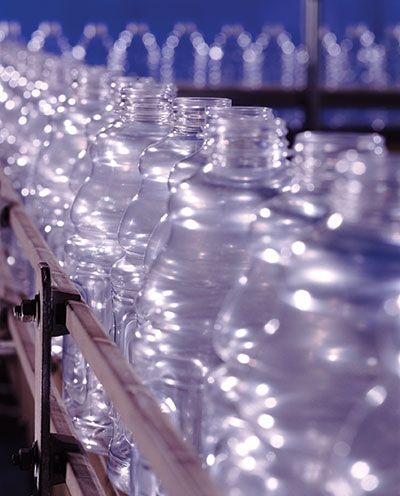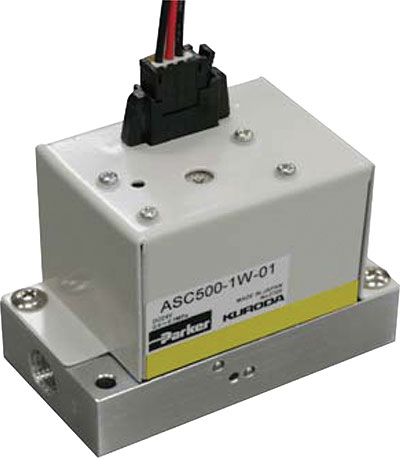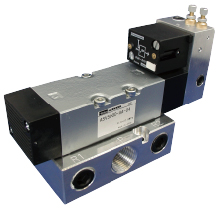Pulsed air blow systems can provide cost-saving alternatives to continually blowing compressed air in bottling and packaging applications.
Contributed by Alex Bakos, Product Sales Manager – controls Parker Hannifin’s Pneumatic Division
As many companies continue to strive toward reducing operating costs, energy consumption is a key area where new technologies can improve the bottom line. One of the largest energy-consuming parts of any factory is compressed air, sometimes referred to as the “fourth utility.” Air compressors consume many kilowatt hours each year to produce the necessary amount of air to power machines throughout packaging plants.

Pulsed air can be used for blowoff in many bottling applications, allowing for energy-efficient removal of particulates. Image courtesy of Parker Hannifin
In a survey conducted by the U.S. Department of Energy, for a typical industrial facility, compressed air accounts for about 10% of all the electricity consumed. By reducing the air consumption at each of the different processes, facilities can also reduce the energy required by the compressor.
Compressed air systems and tools, which are commonly used in a wide variety of industrial applications including packaging, are often missed sources of opportunity as facilities engineers seek additional ways to lower energy consumption and costs. Nearly 50% of industrial plant usage of compressed air is consumed in “blow-off” applications such as removing swarf, which is composed of plastic, cardboard, metal or other debris from the manufacturing process; drying parts; removing products from the conveyor, etc. This supply of air is “uncontrolled,” meaning that it is continually provided via nozzles throughout the day, and is often extremely costly.
Because air compressors frequently outpace other equipment when it comes to energy consumption, reducing their energy consumption can definitely impact the bottom line for packaging facilities. The Department of Energy also found that more than 95% of compressed air systems in industrial use are viable sources for energy reduction. More than 30% of total air usage in plants can be attributed to the method of continual compressed air supply, not accounting for leaks. For these systems, energy savings can vary from 20 to 50%, meaning a large plant with high usage can save in the six figures annually.
Given the potential cost reductions, how can these energy savings be achieved?
Pulsed air blow systems can provide the cost-saving alternative to continually blowing compressed air, because it can reduce consumption up to 50% in certain in-plant machine applications. Consequently, pulsing the air is an effective way to also reduce carbon dioxide emissions.
Plant managers and system designers can use this formula to determine the current cost of compressed air usage in a plant:
• Cost ($) = (bhp) x (0.76) x (number of operating hours x (4/kWh) x (%time) x (% full-load bhp) Motor efficiency
where:
• bhp = motor full-load horsepower (frequently higher than the motor nameplate horsepower; check equipment specification)
• 0.746 = conversion between hp and kW
• Percent time = the percentage of time running at this operating level
• Percent full-load bhp = bhp as the percentage of full-load bhp at this operating level
• Motor efficiency = motor efficiency at this operating level
Commonly, compressed air systems have lower efficiencies ranging from 10 to 15%, making them ideal targets for energy savings and system improvements.
Reduced energy costs

ASC/ASO500 series Air Saver units take the place of previously used electrically operated solenoid valves. The Air Saver can be quickly and easily retrofitted for an immediate reduction in air consumption with no changes to the PLC program. Image courtesy of Parker Hannifin
The U.S. Office of Industrial Technologies estimates costs for compressed air generation to be valued at 15 to 30 cents per 1,000 cubic feet of air, also citing that it can actually account for 30% or more of the electricity consumed in some facilities. That makes compressed air one of the most expensive sources of electricity in a plant.
Without the need for external control, pulsed air blowing is delivered directly to the local work tool, occurring as a rapid set of ON and OFF pulses. This method ensures lower compressed air consumption, which leads to lower energy consumption and higher cost savings. Additionally, air tanks do not need to be recharged as often, which frees workers to focus on other tasks.
Pulsed air presents a major advance in pneumatic technology and efficiency, resulting in substantial energy savings for users. Pulsed air valves can reduce compressed air generation costs by as much as 50% when compared to continual air flow systems, making them ideal to realize energy savings.
Packaging applications that can benefit from pulsed air systems include:
- Surface drying
- Dust removal
- Crumb removal
- Conveyor line blow off
- Air knife applications
- Other continuous blow applications
Improved efficiency
Pulsing compressed air is more effective overall in addition to helping reduce the cost of operations in packaging facilities. Pulsed air generates more agitation than a continual air stream, providing a more effective blow to rapidly strike the work, improving the effectiveness of drying and blow off processes.
A pulsed air valve, such as Parker Hannifin’s Air Saver valve, can be quickly and easily retrofitted into any existing system. The Air Saver does not require any other external control and its efficient design allows it to be installed at the point of application for a variety of uses while the compressor itself remains in its current location.
Pulsed air valves are also simple to install in existing pneumatic systems. Engineers working with systems using solenoid valves to control air blow can easily replace them with pulsed air blow valves without interrupting production schedules or needing to program a PLC controlling air blow at the point of work.
Pulsed air valves offer a range of flow capacities, for example, flows at 5 bar ranging from 150 to 15,000 lpm. Additional valve features include an ON/OFF time adjustment needle, adjustable pulse frequency and duty cycle, as well as models intended for specific applications.
Return on investment is delivered quickly, and the implementation of pulsed air systems can help companies reach environmental and sustainability goals that include reductions in greenhouse gas emissions and energy usage.
Case study: cost-effective replacement in bottling application
Pulsed air blow valves are proving their energy-saving value in a growing range of industries and packaging applications, one of which is soft-drink bottling. A major Chinese soft-drink manufacturer currently uses pulsed air blow valves in its many various pneumatic applications including removing particulates in its PET (polyethylene terephthalate) bottle plants, prior to and following their blow molding process.
Blasts of pulsed ionized air agitate process waste particles which results in highly efficient particle removal and reduced cycle times.
The bottling facility also uses pulsed air to give a secondary blow to the bottles on the conveyor as an escape blow following line stoppages, as well as prior to label attachment. As a result, the soft drink manufacturer realized a nearly 50% reduction in air consumption and associated energy use costs.
Because no programming changes are required to the existing PLC, the pulsed air valve was easily retrofitted into the manufacturer’s production line. It continues to serve as a cost-effective replacement for the previous continuous flow air system, reducing overall air consumption and increasing effectiveness at no subsequent cost.
Easy integration for various applications
I

Parker’s ASV5000 series, which is installed when using manual valves.
n packaging applications, pulsed air blow valves are an effective solution for swarf blowing, from operating machinery into recycling or other containers. Pulsed air is also suitable for print surface drying.
Pulsed air blow valves are equally fit for additional uses across many industries including:
- Electronics manufacturing: Pre-assembly cleaning of components and product surfaces.
- Convection cooling: Pulsed air blow systems are also a low-cost option for forced convection cooling applications.
Various configurations are available to adapt to current pneumatic applications. When working with manual valves such as ball valves, pulsed air valve modules can be quickly installed because they do not require electrical power. When using an electrically operated solenoid valve to control air blow, pulsed air valves can immediately reduce compressed air consumption in retrofit without having to program any changes into the PLC.
Parker Hannifin
parker.com
Filed Under: Pneumatic Tips